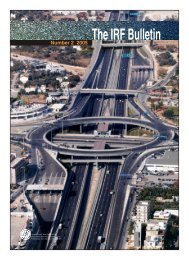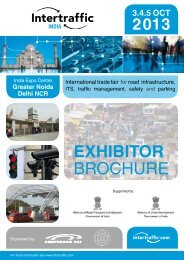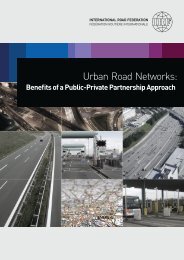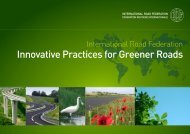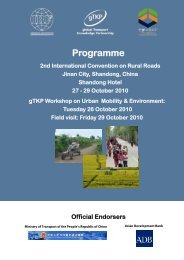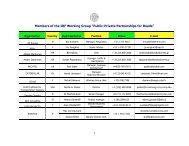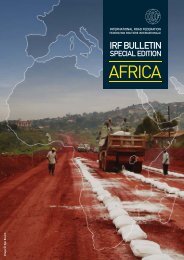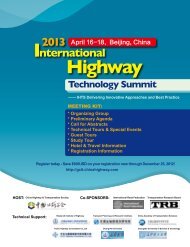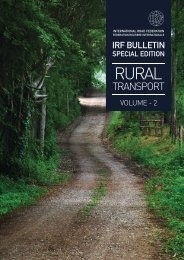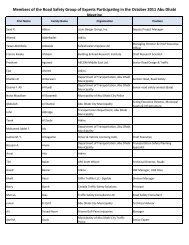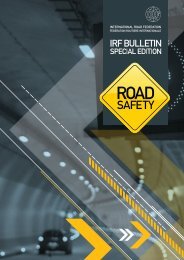Download - IRF | International Road Federation
Download - IRF | International Road Federation
Download - IRF | International Road Federation
You also want an ePaper? Increase the reach of your titles
YUMPU automatically turns print PDFs into web optimized ePapers that Google loves.
TRANS-NATIONAL HIGHWAYS AND NATIONAL PROGRAMMES<br />
TRANS-NATIONAL HIGHWAYS AND<br />
NATIONAL PROGRAMMES<br />
The revival of the old "silk roads" is not a matter of romance but of economic necessity; the new silk roads<br />
have enormous potential for the entire Eurasian continent and especially for the countries of greater Central<br />
Asia. Countries such as India have upgraded their own major highways to complement and enhance such<br />
east-west links. Australia is upgrading its road infrastructure to the level its economy demands.<br />
Boosting trade between<br />
Europe and Asia: The Silk<br />
<strong>Road</strong><br />
Susanna Zammataro<br />
Deputy Director General, <strong>IRF</strong> GPC<br />
In the 14th century it would take a caravan up to a year<br />
to make the 6,000 km Silk <strong>Road</strong> trip, or 10,000 km if one<br />
included the back roads and side trips. Silk was the main<br />
commodity moving from east to west. From the opposite<br />
direction came wool, ivory, glass and precious metals.<br />
Similarly now, most of the traffic along the Silk <strong>Road</strong>s<br />
travels relatively short distances, and international traffic<br />
is less than one in ten of all vehicles. <strong>International</strong> transit<br />
is, however, increasing and is forecast to become a<br />
dominant factor in the future. Most of the international<br />
road traffic is carried on a core network of around 20,000<br />
km of mainly two lane roads.<br />
Almost half the world's cargo traffic consists of goods<br />
transported between Europe and Asia. Currently, the<br />
international trade of the Central Asian countries is some<br />
USD 50 billion, of which 5 billion is trade between the<br />
Central Asian republics themselves. Freight operations on<br />
the Silk <strong>Road</strong>s create annual revenue of over USD 1 billion<br />
for transport companies and transit countries.<br />
Over time all manner of goods were carried along these<br />
roads, from the most expensive cloth to the most<br />
mundane. But few, if any, individuals made the entire<br />
trip. Instead, goods were passed along through an<br />
intricate network of middlemen who rarely travelled<br />
outside their own region.<br />
In the 1990s Turkey, he Caucasian and Central Asia States<br />
agreed to re-establish the Silk <strong>Road</strong> railways, filling in the<br />
missing links between Mashad, Iran and Turkmenistan,<br />
and between Kars, Turkey and Tiblisi, Georgia. The "new<br />
Silk <strong>Road</strong>s" have enormous potential for the entire<br />
Eurasian continent, and especially for the countries of<br />
<strong>IRF</strong> BULLETIN SPECIAL EDITION : ASIA & OCEANIA<br />
04



